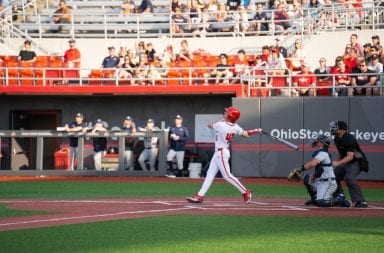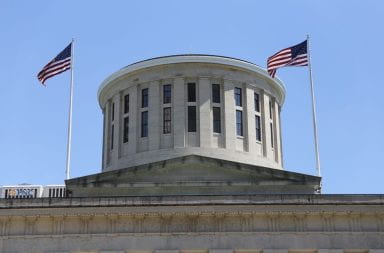
Andre Palmer, center, is the chairman of Ohio State’s Department of Chemical and Biomolecular Engineering. Credit: Courtesy of Ohio State
According to the nonprofit America’s Blood Centers, someone in the United States needs blood every two seconds, and 40,000 pints of blood are transfused in Canada and the U.S. every day.
Andre Palmer, the chairman of Ohio State’s Department of Chemical and Biomolecular Engineering, is trying to create a safe and feasible artificial red blood cell substitute that could be used to save lives and reduce the demand for donations.
The substitute’s main component is the protein hemoglobin, which can be obtained from expired human red blood cells or cow red blood cells. The material has been tested on small animals and showed effectiveness.
“The reason why we have these constant blood drives is because the donated blood could only be stored for 42 days under refrigerated conditions,” Palmer said.
Palmer’s artificial materials, however, can be stored in room temperature for several years without losing activity.
“If blood is not available and you have blood loss, rather than having the patient die, it’s better (to) get transfused by something that could tie you over as a bridge, or give you enough time to get to a hospital to get a proper blood transfusion,” Palmer said.
The artificial blood substitute is universal. It doesn’t express any blood-type antigens, meaning it can be given to any patient, no matter the receiver’s blood type, without causing an immune response.
“If someone gets shot, you don’t have to type and test the blood type of the recipient, you can just transfuse my material in,” Palmer said. “You save a lot of time.”
However, the substitute also comes with drawbacks.
“Some of the side effects of these materials are vasoconstriction, or narrowing of the blood vessels,” Palmer said. “And this gives rise (to) the high blood pressure or hypertension.”
Another side effect is oxidative tissue injury, Palmer said, which damages the transport of oxygen.
However, side effects can be minimized through linking molecules of hemoglobin into a larger collection, among other techniques, to create larger groupings of molecules. Palmer has been researching the red blood cell substitute since 2001. At this point, the substitute has been tested only on smaller animals like guinea pigs and hamsters.
“The animals survive,” Palmer said. “If you make the molecules large enough, the animals don’t experience most of the side effects.”
Donald Belcher, a graduate research associate working on the project, said he joined Palmer’s team with a passion for studying the multifaceted and variety of the molecular interactions.
“I think this research has the importance of actually helping a lot of people,” Belcher said. “There are blood shortages, and issues with combat operations or even natural disasters, but by the materials we are developing … we can potentially save a lot of lives that way.”


